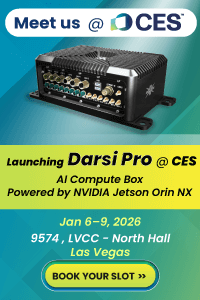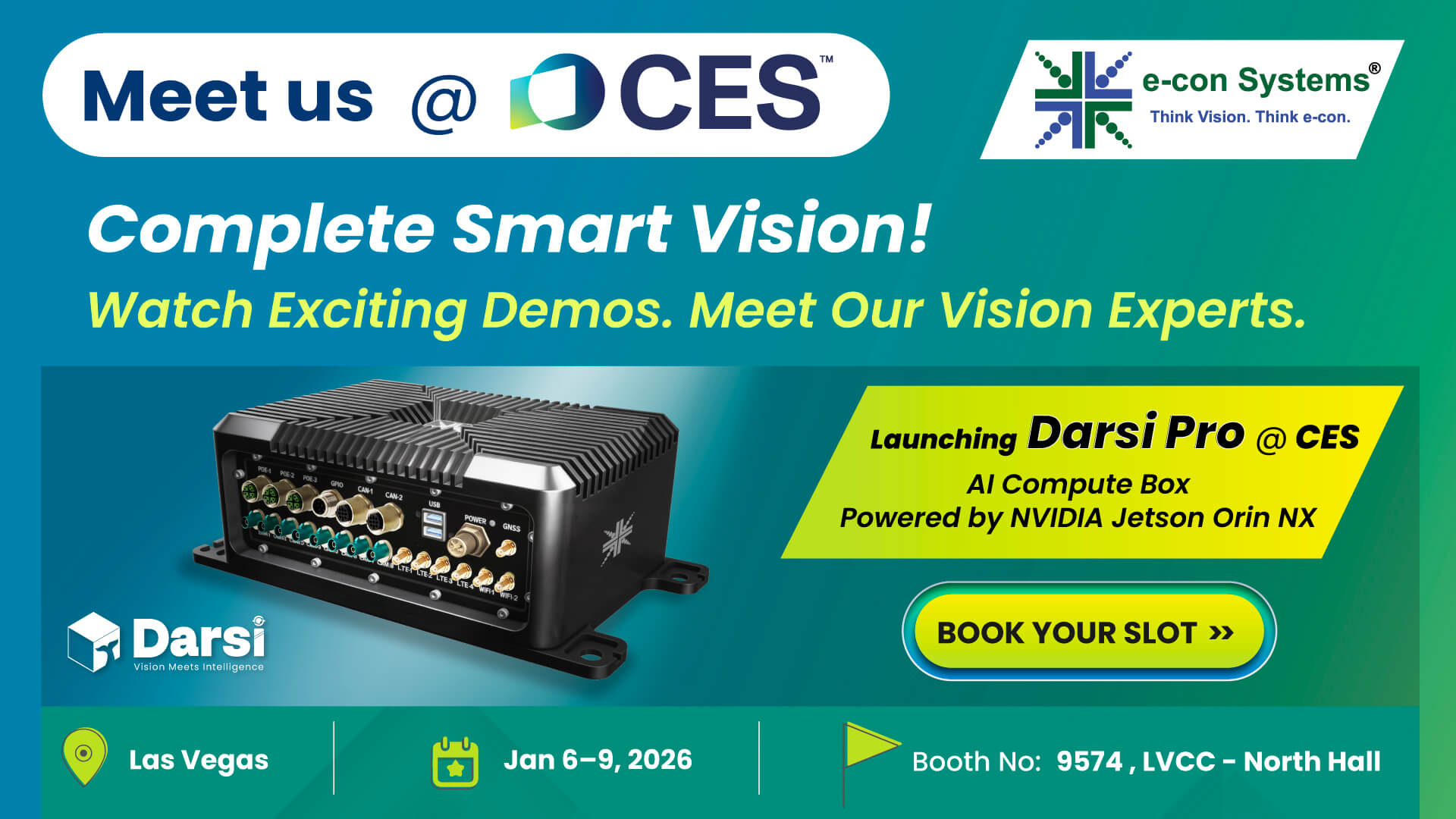Frequently asked questions (FAQ)
- SoM and carrier board
- 1. What is qSmartAI80_CUQ610 vision kit?
- 2. What are the contents of the qSmartAI80_CUQ610 kit?
- 3. Can I design my own carrier board for the SoM that comes with qSmartAI80_CUQ610?
- 4. I want to design a custom vision AI box using the Qualcomm processor with components such as carrier board and enclosure. Would e‑con be able to help with this?
- 5. How long would it take to develop a custom AI vision box using the QCS610 processor?
- 6. Which company manufactures the SoM in the qSmartAI80_CUQ610 vision kit?
- 7. While going for mass production, would you be supplying the SoM?
- 8. I need an IP67-rated enclosure for this kit. Can e‑con support?
- 9. Would I get access to the schematics of the carrier board?
- Camera
- 10. Which interface is used to connect the camera to the QCS610 processor?
- 11. Which is the camera sensor used in this vision kit?
- 12. Which cable is used to connect the camera to the vision kit?
- 13. What is the maximum cable length supported by this AI vision kit?
- 14. I need more than 1 camera to be connected to the host. How do I do that?
- 15. Can I connect a USB camera to this kit?
- 16. Does this kit support GMSL2 cameras for long cable connectivity?
- 17. I need a different lens to cover a wider FoV (Field of View)? How to do it?
- 18. Can I change the lens mount from S-mount to C-mount?
- 19. Can I use this kit under NIR (Near InfraRed) light conditions?
- 20. Does this camera use the internal ISP that comes with the Qualcomm QCS610 processor?
- 21. I have an application that requires finetuning of the ISP specific to the use case. Would e‑con support?
- 22. I want to use a different image sensor other than Sony STARVIS IMX415. Will you be able to support?
- 23. I need a custom camera and I can provide a spec for the same. Would e‑con be able to do this for me?
- 24. While connecting multiple cameras to the host, can I use cameras based on 2 different image sensors?
- 25. While using multiple cameras, can they be synchronized?
- Qualcomm
- 26. Is this vision kit available with the Qualcomm QCS410 processor?
- 27. Does e‑con support cameras for Snapdragon processors?
- 28. I am using NVIDIA Xavier NX as the host platform. Is It better than Qualcomm QCS610?
- 29. I am using an NVIDIA Jetson processor. Which Qualcomm processor is it comparable with?
- 30. I am building an AI-enabled embedded vision device. Which among i.MX8M Plus, NVIDIA Jetson, and Qualcomm should I choose?
- 31. Does this vision kit support H.264 video encoding?
- Software / Application
- 32. Would I be able to develop a camera based application that uses AI algorithms on top of the board?
- 33. What operating systems are supported on the qSmartAI80_CUQ610 vision kit?
- 34. Can I get the BSP source code for this AI vision kit?
- 35. What sample application is provided to evaluate the camera performance?
- 36. Is TensorFlow supported?
- 37. Is the Caffe deep learning framework supported?
- 38. What AI stacks are supported in the vision kit to enable the development of AI applications?
- 39. Does this vision kit support cloud computing for machine learning?
- 40. Would I get Android support for the qSmartAI80_CUQ610 vision kit?
- General
- 41. Can I get a kit on a returnable basis as I don't want to pay for the kit if my application doesn't work?
- 42. Can I get a free sample of qSmartAI80_CUQ610?
- 43. What is the pricing for the development kit and the SoM at volumes of 1K, 5K, 10K etc?
- 44. Is there any MOQ (Minimum Order Quantity) for mass volumes?
- 45. What is the lifetime of this processor?
- 46. There is a general notion that Qualcomm processors typically have a low lifetime. Given this, how long can e‑con Systems supply the vision kit?
- 47. What kind of applications should we target with the qSmartAI80_CUQ610 vision kit?
- 48. What is the warranty available for qSmartAI80_CUQ610 ?
SoM and carrier board
1. What is qSmartAI80_CUQ610 vision kit?
The qSmartAI80_CUQ610 vision kit is an Edge AI vision kit based on the Qualcomm QCS610 processor with a 4K ultra low light camera based on the Sony STARVIS IMX415 sensor. This is a complete ready-to-deploy vision kit using which product developers can right away develop their AI-based embedded vision device.
2. What are the contents of the qSmartAI80_CUQ610 kit?
- A SoM from VVDN Technologies based on the Qualcomm QCS610 processor.
- Carrier board
- 4K ultra low light camera module based on the Sony STARVIS IMX415 sensor
- 30 cm coaxial cable
To learn more about the details of the kit components, the AI stacks that come with it, and its key differentiators, please visit the article Qualcomm QCS610 AI vision kit with e‑con's low light camera module.
3. Can I design my own carrier board for the SoM that comes with qSmartAI80_CUQ610?
Yes. e‑con Systems will be the design partner for carrier board customization. e‑con would provide the final design files (Gerber and BOM) for the customized carrier board. You have the liberty to choose your manufacturing partner. However, e‑con can also help you with the same.
4. I want to design a custom vision AI box using the Qualcomm processor with components such as carrier board and enclosure. Would e‑con be able to help with this?
Yes. Being a complete solution provider, e‑con Systems shall be able to design the custom box with Qualcomm processor including the carrier board, camera, and enclosure according to your specifications.
5. How long would it take to develop a custom AI vision box using the QCS610 processor?
The duration required to develop a custom AI vision box depends on the complexity of your end application. Typically, it ranges from 10 weeks to 20 weeks. For a detailed timeline for building a custom AI vision kit using QCS610, please write to us at camerasolutions@e‑consystems.com.
6. Which company manufactures the SoM in the qSmartAI80_CUQ610 vision kit?
VVDN Technologies manufactures the SoM that comes embedded in qSmartAI80_CUQ610.
7. While going for mass production, would you be supplying the SoM?
Yes. e‑con Systems shall supply the SoM along with the carrier board and camera to its customers.
8. I need an IP67-rated enclosure for this kit. Can e‑con support?
Yes, of course. e‑con's portfolio of cameras includes IP67-rated cameras that are tested for quality and endurance. Apart from that, e‑con has helped several customers build custom IP67-rated enclosures for its camera modules. Given below are two of e‑con's off-the-shelf products that come with an IP67/66 rated enclosure (as mentioned before, e‑con can design an IP67 rated enclosure for any of the products in its portfolio. Please visit the Camera Selector to have a look at our complete list of cameras by features):
9. Would I get access to the schematics of the carrier board?
Being a Qualcomm partner, e‑con Systems shall help design, develop, and manufacture the carrier board for customers according to their specifications. If e‑con is customizing the carrier board for you, we shall share the schematics for the custom design.
Camera
10. Which interface is used to connect the camera to the QCS610 processor?
This AI vision kit uses a 4 lane MIPI-CSI2 interface to connect the camera and the processor. To learn more about MIPI cameras, please have a look at the article What is a MIPI camera? How does MIPI camera work?
11. Which is the camera sensor used in this vision kit?
This vision kit has a Sony STARVIS IMX415 ultra low light camera module. The Sony STARVIS series of sensors is known for its high sensitivity and superior low light performance. From Exmor to Exmor R to Exmor RS and STARVIS, Sony sensors have gotten better over time. To learn the differences between various types of Sony sensors, please read the article Sony Exmor vs STARVIS sensors - a detailed comparison.
12. Which cable is used to connect the camera to the vision kit?
As mentioned before, the camera is using the MIPI interface to connect to the Qualcomm host. And the connection is done using a high quality coaxial cable.
13. What is the maximum cable length supported by this AI vision kit?
This vision kit comes with a 30 cm coaxial cable by default. However, e‑con supports cables up to a length of 1 meter, which requires a customization. For any help in altering the cable length of this vision kit, please write to us at camerasolutions@e‑consystems.com. You could also visit the OEM camera customization page to learn more about all the customization services offered by e‑con Systems.
14. I need more than 1 camera to be connected to the host. How do I do that?
Currently the qSmartAI80_CUQ610 kit hardware supports up to 3 cameras. Software support is provided to connect and integrate 2 cameras for now. However, driver support for the 3rd camera can be taken up as a customization request.
15. Can I connect a USB camera to this kit?
Yes. This kit supports 1 x USB3.1 and 2 x USB 2.0 interfaces. Hence you have the choice to connect any USB camera to this kit. Please visit the USB3 cameras and USB2 cameras pages to have a look at e‑con Systems' complete portfolio of USB cameras.
16. Does this kit support GMSL2 cameras for long cable connectivity?
Currently, this kit comes with driver support for MIPI-CSI2 cameras. Supporting GMSL2 cameras is very much possible. In case you are looking to customize the camera to connect to the host using the GMSL2 interface, please write to us at camerasolutions@e‑consystems.com with your detailed requirements. Meanwhile, please have a look at our complete portfolio of GMSL cameras here.
17. I need a different lens to cover a wider FoV (Field of View)? How to do it?
The camera comes with an M12 lens holder. Hence, you shall be able to use any standard S-mount lens (M12 x 0.5) with the default lens holder. Please write to camerasolutions@e‑consystems.com for lens suggestions.
18. Can I change the lens mount from S-mount to C-mount?
It is possible to support a C-mount lens holder as a hardware customization effort. Please visit the OEM camera customization page to have a look at all the customization services we provide. You could also write to us at camerasolutions@e‑consystems.com for any help with camera customization.
19. Can I use this kit under NIR (Near InfraRed) light conditions?
The default lens supplied with the camera has an IR cut filter that filters light in the InfraRed spectrum. If you wish to use the camera in NIR conditions, we recommend you to test it using a different lens that passes IR through it. For any help in choosing a different lens, kindly write to us at camerasolutions@e‑consystems.com. To learn what an NIR camera is and the various NIR cameras offered by e‑con Systems, please do have a look at the article What is NIR imaging and how do NIR cameras work?
20. Does this camera use the internal ISP that comes with the Qualcomm QCS610 processor?
Yes. This camera uses the internal ISP of Qualcomm QCS610.
21. I have an application that requires finetuning of the ISP specific to the use case. Would e‑con support?
Yes. e‑con would support any finetuning required on the Qualcomm ISP to meet your specifications. ISP tuning is one of e‑con's key areas of expertise. Our ISP tuning capabilities have helped us win numerous deals against some of our top competitors.
22. I want to use a different image sensor other than Sony STARVIS IMX415. Will you be able to support?
Yes. e‑con Systems shall be able to support the integration of any image sensor with the Qualcomm AI vision kit. However, e‑con is already having a no of cameras with a wide variety of sensors from Sony, Onsemi, and Omnivsion. Please visit the Camera Selector to have a look at e‑con's complete portfolio of cameras based on these sensors.
23. I need a custom camera and I can provide a spec for the same. Would e‑con be able to do this for me?
Yes. This would be a custom solution. e‑con Systems shall be able to design a custom camera with the necessary drivers.
24. While connecting multiple cameras to the host, can I use cameras based on 2 different image sensors?
Yes. It is possible to connect cameras with different sensors to a single board.
25. While using multiple cameras, can they be synchronized?
Camera synchronization shall be provided as a customization service. e‑con Systems offers various camera solutions with multiple synchronized cameras. The multi-camera solution with 180 degree stitching for NVIDIA Jetson AGX Xavier is an example for this.
Qualcomm
26. Is this vision kit available with the Qualcomm QCS410 processor?
Yes. This vision kit comes with QCS410 based SoM as well. We will be launching the same with required software support soon. Please write to camerasolutions@e‑consystems.com in case you are looking for a QCS410 based solution.
27. Does e‑con support cameras for Snapdragon processors?
Yes. We have a camera solution available for DragonBoard 820c development board which is based on the Qualcomm Snapdragon 820E embedded platform with the 64-bit Qualcomm Kryo quad-core CPU. Here is the link to the product: e-CAM51_CU96 - 5MP camera for Qualcomm DragonBoard 820C.
28. I am using NVIDIA Xavier NX as the host platform. Is It better than Qualcomm QCS610?
Every application is unique and the host processor has to be chosen by taking into consideration a multitude of factors. It is recommended to have a discussion with our camera solution experts who would be able to help you with this. Please write to camerasolutions@e‑consystems.com to set up a consultation call with our experts.
29. I am using an NVIDIA Jetson processor. Which Qualcomm processor is it comparable with?
NVIDIA offers a wide variety of processors including NVIDIA Jetson Nano, Xavier NX, TX2 NX, AGX Xavier, AGX Orin, etc. Each of them comes with a wide range of performance starting from 472 GFLOPS to all the way till 275 TOPS. To understand which of these platforms you are using, we recommend you to setup a discussion with our camera solution experts who would be able to give you the necessary details of each processing platform. They can also help you with choosing the right platform for your embedded device. For any such help, please write to camerasolutions@e‑consystems.com.
30. I am building an AI-enabled embedded vision device. Which among i.MX8M Plus, NVIDIA Jetson, and Qualcomm should I choose?
All the 3 series of processors come with a varied range of performance. i.MX 8M Plus - with its Neural Processing Unit operating at up to 2.3 TOPS - is suitable for low end AI applications such as face detection and recognition. Please visit the NXP cameras page to have a look at e‑con's portfolio of NXP cameras including those compatible with i.MX 8M Plus.
As mentioned before, NVIDIA Jetson processors are suitable for high end AI applications that require as many as 40+ cameras. For instance, Jetson AGX Orin - which is the latest addition to NVIDIA's portfolio of processors - comes with the highest performance of 275 TOPS (with 64 GB memory). Hence, NVIDIA processors are typically the best for high end AI applications that have a heavy computational load.
On the other hand, the latest Qualcomm processors are suitable for low end/medium end AI applications such as face detection, face recognition, object tracking, and people counting.
To know how to choose the best processing platform for your AI application, please write to us at camerasolutions@e‑consystems.com.
31. Does this vision kit support H.264 video encoding?
Yes. Qualcomm QCS610 supports H.264 encoding up to a resolution of 4K@30fps.
Software / Application
32. Would I be able to develop a camera based application that uses AI algorithms on top of the board?
Yes. e‑con Systems provides the complete ecosystem for customers to develop and deploy their own algorithms on top of the kit. We shall provide the necessary integration support for the AI SDKs that come with the kit. Please refer question #38 to learn in detail about the AI SDKs available in qSmartAI80_CUQ610.
33. What operating systems are supported on the qSmartAI80_CUQ610 vision kit?
Linux Yocto.
34. Can I get the BSP source code for this AI vision kit?
e‑con Systems shall be able to help you with any necessary customization on the BSP side.
35. What sample application is provided to evaluate the camera performance?
Gstreamer based sample application is provided to test and evaluate this smart camera kit.
36. Is TensorFlow supported?
Yes. Please refer question no #38 for more info.
37. Is the Caffe deep learning framework supported?
Yes. Both Caffe and Caffe2 frameworks are supported. Please refer question #38 for more info.
38. What AI stacks are supported in the vision kit to enable the development of AI applications?
Following are the AI stacks supported by qSmartAI80_CUQ610
- Qualcomm Neural Processing SDK for AI: This Qualcomm AI-based Neural Processing SDK enables product developers to run one or more machine learning and neural network models trained in Caffe/Caffe2, ONNX, or TensorFlow.
- Neural Network API (TFLite models); The Neural Network API provides acceleration for TensorFlow Lite models with supported hardware accelerators including a GPU (Graphics Processing Unit), DSP (Digital Signal Processor), and NPU (Neural Processing Unit).
- GStreamer plugin (DLC models): The GStreamer DLC plugin (qtimlesnpe plugin) helps to smoothly integrate a .dlc to the available GStreamer plugins.
- GStreamer TFLite plugin: This GStreamer plugin (qtimletflite plugin) exposes TensorFlow Lite capabilities to GStreamer. While the pre-processing functionality supports downscale, color convert, mean subtraction, and padding, post-processing supports models such as classification, detection, and segmentation.
Please refer Machine Learning on QCS610 - Qualcomm Developer Network for more details.
39. Does this vision kit support cloud computing for machine learning?
Yes. Qualcomm provides support for Microsoft Azure machine learning and other Azure services.
40. Would I get Android support for the qSmartAI80_CUQ610 vision kit?
Android support will be available once Qualcomm provides it.
General
41. Can I get a kit on a returnable basis as I don't want to pay for the kit if my application doesn't work?
Yes. e‑con is ready to provide this kit on a returnable basis for evaluation given that the customer is having the right use case and mass volume requirements. Please contact sales@e‑consystems.com if you are looking to avail this offer. However, it is to be noted that providing the kit is completely e‑con's discretion.
42. Can I get a free sample of qSmartAI80_CUQ610?
e‑con is willing to provide this kit on a returnable basis for evaluation given that the customer is having the right use case and mass volume requirements. Please write to sales@e‑consystems.com for more details on this. However, e‑con holds the right to take a call on whether a prospect gets a free sample or not.
43. What is the pricing for the development kit and the SoM at volumes of 1K, 5K, 10K etc?
For any pricing related information, please contact us at sales@e‑consystems.com.
44. Is there any MOQ (Minimum Order Quantity) for mass volumes?
Yes. 1000 is the MOQ for mass volume production.
45. What is the lifetime of this processor?
As the case with all our camera modules, e‑con Systems shall supply this Qualcomm kit for a minimum of 5 years.
46. There is a general notion that Qualcomm processors typically have a low lifetime. Given this, how long can e‑con Systems supply the vision kit?
As mentioned in the previous response, e‑con Systems shall supply the vision kit for a minimum of 5 years.
47. What kind of applications should we target with the qSmartAI80_CUQ610 vision kit?
Qualcomm QCS610 is suitable for any mid-tier AI application. Examples for such applications include telepresence robots, service robots, smart carts, digital signages, smart traffic systems, etc. If you wish to have a brainstorming around how to build your next camera-based embedded device using Qualcomm QCS610 and e‑con cameras, please feel free to write to us at camerasolutions@e‑consystems.com.
48. What is the warranty available for qSmartAI80_CUQ610 ?
All off-the-shelf products from e‑con Systems come with a 3-year warranty which applies to qSmartAI80_CUQ610 as well. Please have a look at our warranty page for more details.



 Mr. Thomas Yoon
Mr. Thomas Yoon +82-10-5380-0313
+82-10-5380-0313







